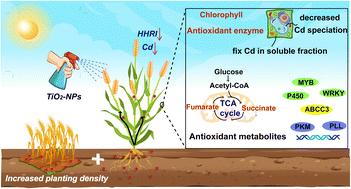当前位置:
X-MOL 学术
›
Environ. Sci.: Nano
›
论文详情
Our official English website, www.x-mol.net, welcomes your
feedback! (Note: you will need to create a separate account there.)
Synergistic effect of foliar exposure to TiO2 nanoparticles and planting density modulates the metabolite profile and transcription to alleviate cadmium induced phytotoxicity to wheat (Triticum aestivum L.)
Environmental Science: Nano ( IF 5.8 ) Pub Date : 2024-11-18 , DOI: 10.1039/d4en00763h Min Wang, Junxiao Luo, Hongbo Li, Chenghao Ge, Feng Jing, Jingxia Guo, Qingya Zhang, Xuezhen Gao, Cheng Cheng, Dongmei Zhou
Environmental Science: Nano ( IF 5.8 ) Pub Date : 2024-11-18 , DOI: 10.1039/d4en00763h Min Wang, Junxiao Luo, Hongbo Li, Chenghao Ge, Feng Jing, Jingxia Guo, Qingya Zhang, Xuezhen Gao, Cheng Cheng, Dongmei Zhou

|
A reasonable planting density is vital for wheat resource efficiency and yield enhancement. However, systematic research on the impact of spraying TiO2-NPs on wheat growth, metabolism, and stress tolerance cultivated in cadmium (Cd)-contaminated soil is limited, especially in integration with planting density, requiring a deeper understanding. Our study showed that spraying with 3.1 mg per plant TiO2-NPs (in pots) and 21.6 mg m−2 TiO2-NPs combined with high planting densities (in the field) both significantly reduced the Cd content in wheat grains by 27.9 and 35.7%, respectively. Immobilization of subcellular water-soluble Cd and the conversion of Cd into inactive plant components in leaves were the primary reasons for this reduction. Metabolomics further revealed the up-regulation of metabolites related to antioxidant activity, plant stress resistance, growth promotion, and the tricarboxylic acid (TCA) cycle, which promotes plant growth, enhances wheat antioxidant enzyme activity, and alleviates oxidative stress. Transcriptomic analysis validated the association between these responses and improved plant stress resistance, with genes such as MYB, WRKY, P450, and Cd membrane transport-related genes like ABCG2 and ABCC3 contributing to the decrease in Cd levels in wheat. Importantly, the Cd-associated human health risk index was also reduced via foliar TiO2-NPs application. Overall, foliar spraying of TiO2-NPs combined with high plant density was beneficial in alleviating Cd levels in wheat grains, limiting the risk of Cd exposure to human health via the food chain.
中文翻译:

叶面暴露于 TiO2 纳米颗粒和种植密度的协同作用调节代谢物谱和转录,以减轻镉诱导的对小麦 (Triticum aestivum L.) 的植物毒性。
合理的种植密度对于小麦资源效率和产量提高至关重要。然而,关于喷施 TiO2-NPs 对镉 (Cd) 污染土壤中小麦生长、代谢和抗逆性影响的系统研究有限,尤其是在与种植密度相结合的情况下,需要更深入的了解。我们的研究表明,每株喷施 3.1 mg TiO2-NPs(花盆中)和 21.6 mg m-2 TiO2-NPs 结合高种植密度(田间)均显著降低小麦籽粒中的 Cd 含量分别降低了 27.9% 和 35.7%。亚细胞水溶性 Cd 的固定化以及 Cd 在叶片中转化为无活性的植物成分是这种减少的主要原因。代谢组学进一步揭示了与抗氧化活性、植物抗逆性、生长促进和三羧酸 (TCA) 循环相关的代谢物的上调,从而促进植物生长,增强小麦抗氧化酶活性,缓解氧化应激。转录组学分析验证了这些反应与植物抗逆性提高之间的关联,MYB 、 WRKY 、 P450 等基因和 Cd 膜转运相关基因(如 ABCG2 和 ABCC3 )导致小麦 Cd 水平降低。重要的是,叶面喷施 TiO2-NPs 也降低了与 Cd 相关的人类健康风险指数。总体而言,叶面喷施 TiO2-NPs 结合高植物密度有利于缓解小麦籽粒中的 Cd 水平,限制了 Cd 通过食物链暴露于人类健康的风险。
更新日期:2024-11-18
中文翻译:

叶面暴露于 TiO2 纳米颗粒和种植密度的协同作用调节代谢物谱和转录,以减轻镉诱导的对小麦 (Triticum aestivum L.) 的植物毒性。
合理的种植密度对于小麦资源效率和产量提高至关重要。然而,关于喷施 TiO2-NPs 对镉 (Cd) 污染土壤中小麦生长、代谢和抗逆性影响的系统研究有限,尤其是在与种植密度相结合的情况下,需要更深入的了解。我们的研究表明,每株喷施 3.1 mg TiO2-NPs(花盆中)和 21.6 mg m-2 TiO2-NPs 结合高种植密度(田间)均显著降低小麦籽粒中的 Cd 含量分别降低了 27.9% 和 35.7%。亚细胞水溶性 Cd 的固定化以及 Cd 在叶片中转化为无活性的植物成分是这种减少的主要原因。代谢组学进一步揭示了与抗氧化活性、植物抗逆性、生长促进和三羧酸 (TCA) 循环相关的代谢物的上调,从而促进植物生长,增强小麦抗氧化酶活性,缓解氧化应激。转录组学分析验证了这些反应与植物抗逆性提高之间的关联,MYB 、 WRKY 、 P450 等基因和 Cd 膜转运相关基因(如 ABCG2 和 ABCC3 )导致小麦 Cd 水平降低。重要的是,叶面喷施 TiO2-NPs 也降低了与 Cd 相关的人类健康风险指数。总体而言,叶面喷施 TiO2-NPs 结合高植物密度有利于缓解小麦籽粒中的 Cd 水平,限制了 Cd 通过食物链暴露于人类健康的风险。


















































 京公网安备 11010802027423号
京公网安备 11010802027423号